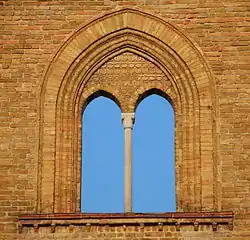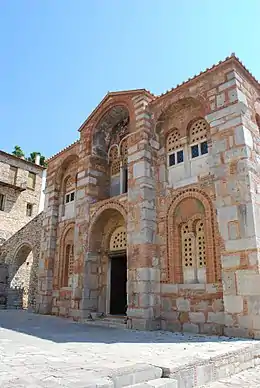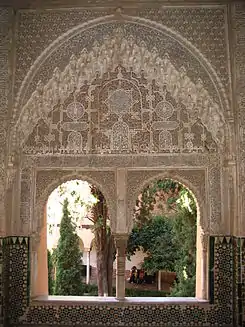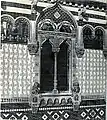Bifora (architecture)
A bifora is a type of window divided vertically in two openings by a small column or a pilaster; the openings are topped by arches, round or pointed.[1][2][3] Sometimes the bifora is framed by a further arch; the space between the two arches may be decorated with a coat of arms or a small circular opening.

The bifora was used in Byzantine architecture, including Italian buildings such as the Basilica of Sant'Apollinare Nuovo, in Ravenna. Typical of the Romanesque and Gothic periods, in which it became an ornamental motif for windows and belfries, the bifora was also often used during the Renaissance period.[4] In Baroque architecture and Neoclassical architecture the bifora was largely forgotten, or replaced by elements like the three openings of the Venetian window. It was also copied in the Moorish architecture in Spain.
It returned in vogue in the nineteenth century in the period of eclecticism and rediscovery of the ancient styles in Gothic Revival and Romanesque Revival architecture.
Gallery
 11th-century monastery of Hosios Loukas in Greece, representative of Byzantine style under the Macedonian dynasty
11th-century monastery of Hosios Loukas in Greece, representative of Byzantine style under the Macedonian dynasty
 A gothic bifora, Bochum-Stiepel (Germany)
A gothic bifora, Bochum-Stiepel (Germany) A Romanic bifora, Casina, Oratorio di Beleo
A Romanic bifora, Casina, Oratorio di Beleo

 Palazzo del Granchio, Messina
Palazzo del Granchio, Messina
See also
References
- Smith, Timothy B. (2017). Art as Politics in Late Medieval and Renaissance Siena. Routledge. p. 53. ISBN 9781351575591. Retrieved 23 July 2019.
- Johnson, Paul (1980). British Cathedrals. W. Morrow. p. 61. ISBN 9780688036720. Retrieved 23 July 2019.
- Acta Ad Archaeologiam Et Artium Historiam Pertinentia: 4o. "L'Erma" di Bretschneider. 1975. p. 171. Retrieved 23 July 2019.
- Ireland, Jeannie (2008). History of Interior Design. Bloomsbury Academic. p. 231. ISBN 9781563674624. Retrieved 23 July 2019.
